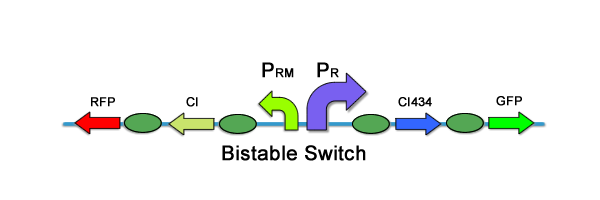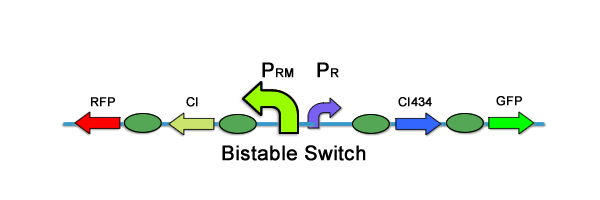|
Project > Bistable > Design
Abstract
Bi-stable part is one of the core achievements of PKU07 iGEM team. We inherited the part and utilized it to function as a memorizer in our own system. This bi-stable module can be stabilized as either of the two states in a relatively long period of time without any external stimuli, while under certain circumstances, one state can be turned over to the other. These two properties meet the requirements as a memorizer in our system. The two states can be utilized as two states of a memory, and the alteration from one state to the other functions as the process of a memory foundation. Moreover, the natural switchover from one state to the other can accurately mimic the oblivion phenomenon.
The logic design and construction of bi-stable module
The bi-stable part is composed of CI and CI434 which repressed each other in transcription. As is seen in the logic picture, both of the two coding genes are constructed after the promoter which is repressed by the other, and CI can also play the role of an activator of its own promoter. GFP and mRFP are separately constructed after CI and CI434 coding gene as reporters of the different states. In state 1, when CI is expressed, the promoter before CI434 is repressed, leading to the downregulation of CI434. Thus the repression of the promoter before CI is removed, positively upregulates the expression of CI. As is the same of state1, in state 2, when CI434 is highly expressed, the expression of CI is repressed and the state can be stabilized in CI434 high level of expression.
 fig1. The logic design and construction of bi-stable module The bi-stable module is constructed based on the natural switch in Lamda phage, which composed of CI and Cro. The Cro coding sequence is substituted by CI434 and the Cro repressible promoter is modified so that it can be repressed by CI434. For more details, please visit
PKU07 iGEM team project
Expected functions in different conditions when utilized in the whole system
Situation 1: No memory
When the system has never been triggered by the inputs, bi-stable module is stabilized in the state of CI434, which the level of CI is low.
 fig2. Situation when the system has no memory Situation 2: Foundation of a memory
When the system is triggered by the two stimuli at the same time, the expression of CI is upregulated externally, represses the CI repressible promoter before CI434, negatively regulating the expression level of CI434. As a result, the CI434 repressible promoter before CI coding sequence is no longer repressed by CI434 and is activated by CI protein, leading to the possible feedback. The state is turned from CI434 to CI high expression in this way, mimicking the foundation of the memory.
Situation 3: With memory
The state of CI high expression represents the state with memory, and the state can stay a relatively long time without any external trigger.
 fig3. SItuation when the system has memory Situation 4: Oblivion
The bi-stable part we chose is more stable at the state of CI434, thus, without any external triggers, the state of CI (with memory) can automatically turned to the state of CI434 because of the decay of CI. This process can accurately describe the natural oblivion.
^Top
|